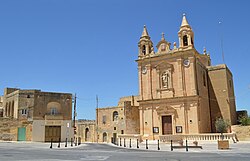Munxar
|
Munxar Il-Munxar |
|||
|---|---|---|---|
| Local council | |||

View of Munxar parish church and surroundings
|
|||
|
|||
 |
|||
| Coordinates: 36°1′49″N 14°14′7″E / 36.03028°N 14.23528°ECoordinates: 36°1′49″N 14°14′7″E / 36.03028°N 14.23528°E | |||
| Country |
|
||
| Region |
|
||
| District | Gozo and Comino District | ||
| Borders | Fontana, Kerċem, Sannat, Xewkija | ||
| Government | |||
| • Mayor | Carmen Said (PL) | ||
| Area | |||
| • Total | 2.8 km2 (1.1 sq mi) | ||
| Population (March 2014) | |||
| • Total | 1,454 | ||
| • Density | 520/km2 (1,300/sq mi) | ||
| Demonym(s) | Munxari (m), Munxarija (f), Munxarin (pl) | ||
| Time zone | CET (UTC+1) | ||
| • Summer (DST) | CEST (UTC+2) | ||
| Postal code | MXR | ||
| Dialing code | 356 | ||
| ISO 3166 code | MT-36 | ||
| Patron saint | St. Paul | ||
| Website | Official website | ||
Munxar (Maltese: Il-Munxar) is a village which lies on the southern side of Gozo, Malta, close to the village of Sannat. It has its own local council. As of March 2014, the Munxar population was 1,454.
The name Munxar is from the Maltese language; the English translation is "bucksaw" –the teeth of the saw are represented in the village flag.
Close by to this village, there is Xlendi Bay, a popular tourist resort engulfed in a fjord like inlet amongst high cliffs. Xlendi bay is a small fishing village, but is also an ideal bathing and diving resort especially in summer. Otherwise, foreigners and locals enjoy the late spring and early autumn sunsets often captured by artists or keen photographers.
The parish church, a small baroque building built from the typical Maltese stone, is dedicated to St. Paul. It was built between 1914 and 1925 and was consecrated on 18 October 1925. Bishop Giuseppe Pace established it as a parish church on 12 December 1957. As a result, Munxar was the last village in Gozo to become an autonomous parish. The feast officially falls on 10 February which is also a national public holiday; however, the outside festivities are celebrated on the third Sunday of each May.
One of the people of note to have been born and lived in this village is Professor Joseph Aquilina.
The first records that were found recording Munxar as an area dates back to the sixteenth century when the area was named Monxiar, which means a bucksaw, taking its name from the two valleys running parallel from the village. From a sixteenth-century census, the village had a population of around 200 inhabitants. The first surnames recorded in the census were Attard, Barberi, Hagius, among a few others which suggests that these were the first Munxarin. In that time, Monxiar and Xlendi were part of the village of Sannat. At the time, the population of Xlendi was only 8 persons – the tower guardian and his family who lived in Xlendi tower.
Remains of a megalithic temple were found in limits of Ta' Marżiena and also Roman remains were found in Xlendi valley. Geographically, Munxar has always formed part of the neighbouring village of Sannat. People of Munxar attended their spiritual needs at Saint Maragret parish at Sannat; however, historical facts and documented evidence points the existence of three other chapels, now completely demolished.
...
Wikipedia


